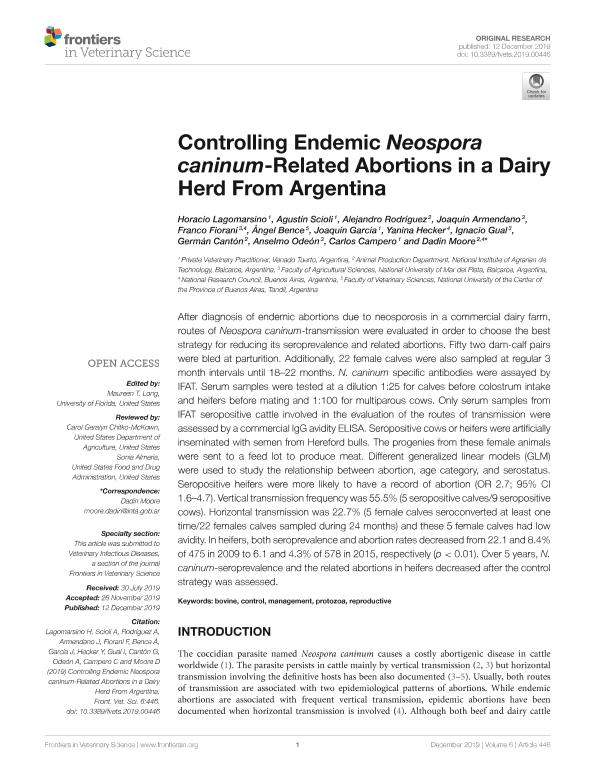Artículo
Controlling Endemic Neospora caninum-Related Abortions in a Dairy Herd From Argentina
Lagomarsino, H.; Scioli, Agustín; Rodríguez, Alejandro; Armendano, Joaquín Ignacio; Fiorani, Franco ; Bence, Ángel; García, Joaquín; Hecker, Yanina Paola
; Bence, Ángel; García, Joaquín; Hecker, Yanina Paola ; Gual, Ignacio
; Gual, Ignacio ; Cantón, Germán; Odeón, Anselmo; Campero, Carlos Manuel; Moore, Dadin Prando
; Cantón, Germán; Odeón, Anselmo; Campero, Carlos Manuel; Moore, Dadin Prando
 ; Bence, Ángel; García, Joaquín; Hecker, Yanina Paola
; Bence, Ángel; García, Joaquín; Hecker, Yanina Paola ; Gual, Ignacio
; Gual, Ignacio ; Cantón, Germán; Odeón, Anselmo; Campero, Carlos Manuel; Moore, Dadin Prando
; Cantón, Germán; Odeón, Anselmo; Campero, Carlos Manuel; Moore, Dadin Prando
Fecha de publicación:
12/2019
Editorial:
Frontiers Media
Revista:
Frontiers in Veterinary Science
ISSN:
2297-1769
Idioma:
Inglés
Tipo de recurso:
Artículo publicado
Clasificación temática:
Resumen
After diagnosis of endemic abortions due to neosporosis in a commercial dairy farm, routes of Neospora caninum-transmission were evaluated in order to choose the best strategy for reducing its seroprevalence and related abortions. Fifty two dam-calf pairs were bled at parturition. Additionally, 22 female calves were also sampled at regular 3 month intervals until 18–22 months. N. caninum specific antibodies were assayed by IFAT. Serum samples were tested at a dilution 1:25 for calves before colostrum intake and heifers before mating and 1:100 for multiparous cows. Only serum samples from IFAT seropositive cattle involved in the evaluation of the routes of transmission were assessed by a commercial IgG avidity ELISA. Seropositive cows or heifers were artificially inseminated with semen from Hereford bulls. The progenies from these female animals were sent to a feed lot to produce meat. Different generalized linear models (GLM) were used to study the relationship between abortion, age category, and serostatus. Seropositive heifers were more likely to have a record of abortion (OR 2.7; 95% CI 1.6–4.7). Vertical transmission frequency was 55.5% (5 seropositive calves/9 seropositive cows). Horizontal transmission was 22.7% (5 female calves seroconverted at least one time/22 females calves sampled during 24 months) and these 5 female calves had low avidity. In heifers, both seroprevalence and abortion rates decreased from 22.1 and 8.4% of 475 in 2009 to 6.1 and 4.3% of 578 in 2015, respectively (p < 0.01). Over 5 years, N. caninum-seroprevalence and the related abortions in heifers decreased after the control strategy was assessed.
Palabras clave:
BOVINE
,
CONTROL
,
MANAGEMENT
,
PROTOZOA
,
REPRODUCTIVE
Archivos asociados
Licencia
Identificadores
Colecciones
Articulos(CCT - MAR DEL PLATA)
Articulos de CTRO.CIENTIFICO TECNOL.CONICET - MAR DEL PLATA
Articulos de CTRO.CIENTIFICO TECNOL.CONICET - MAR DEL PLATA
Citación
Lagomarsino, H.; Scioli, Agustín; Rodríguez, Alejandro; Armendano, Joaquín Ignacio; Fiorani, Franco; et al.; Controlling Endemic Neospora caninum-Related Abortions in a Dairy Herd From Argentina; Frontiers Media; Frontiers in Veterinary Science; 6; 12-2019; 1-5
Compartir
Altmétricas



